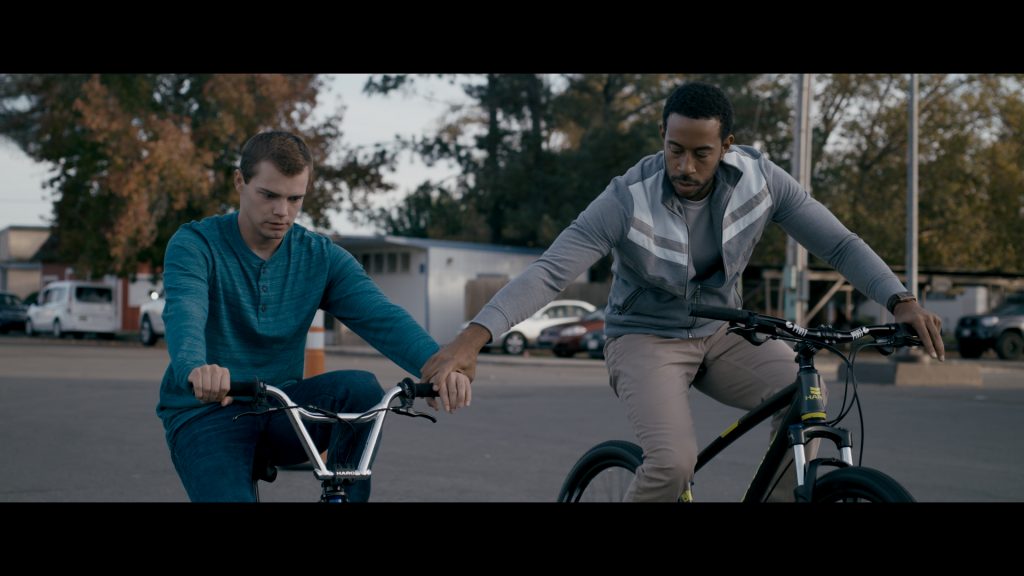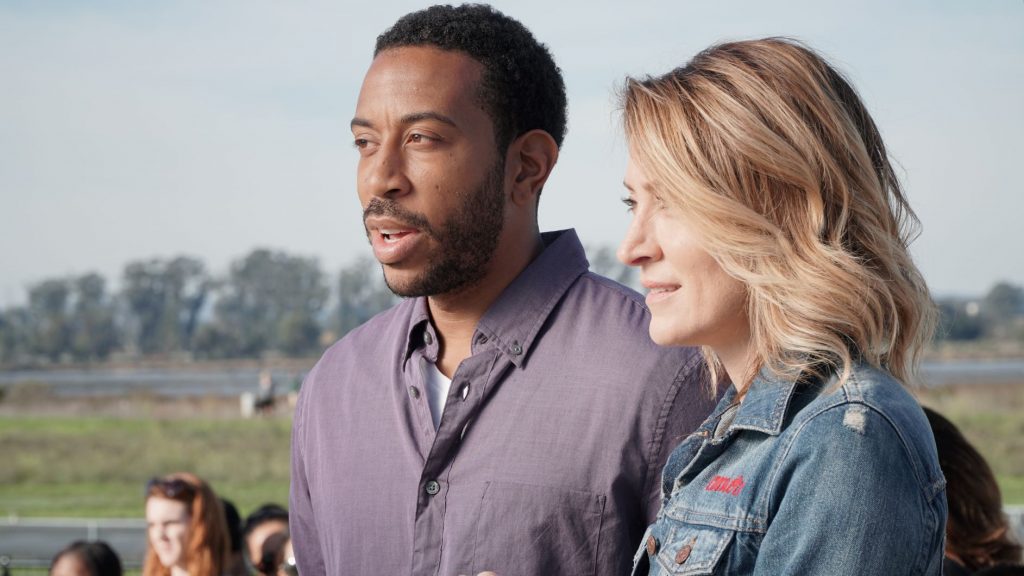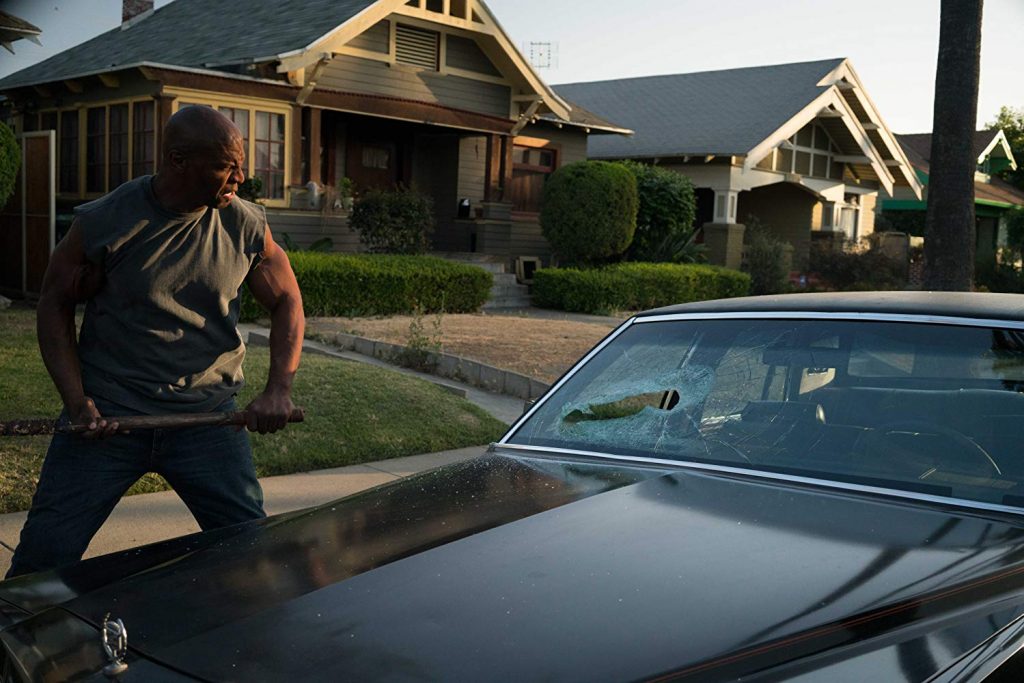February 27, 2021
by Carla Hay

Directed by Alex Ranarivelo
Culture Representation: Taking place in Northern California and other parts of the U.S., the dramatic film “The Ride” (which is based on a true story) features a predominantly white cast of characters (with some African Americans, Asians and Latinos) representing the middle-class, working-class and criminal underground.
Culture Clash: A juvenile delinquent, who was taught to be a white supremacist, is fostered and then adopted by an interracial couple, and he learns that he has a talent for BMX racing.
Culture Audience: “The Ride” will appeal primarily to people interested in real-life stories of redemption, even if it’s told in a very predictable and formulaic way.

“The Ride” is a biographical dramatic film that sticks to a certain formula that movies tend to have when they’re about people who’ve been able to overcome a troubled past to achieve some greatness. Based on the true story of professional BMX rider John Buultjens (formerly known as John McCord), “The Ride” takes a while to get to the heart of the story, it soars when it shows John’s transformation, and then it becomes a conventional sports competition by the end of the film. Despite having a lot of expected tropes, the cast members’ performances are appealing enough to make this movie worth checking out if people are looking for an inspirational and uplifting story.
Directed by Alex Ranarivelo, “The Ride” begins in Northern California, where most of the story takes place. John McCord (played by Alexander Davis) is only 9 years old, but he’s already living like an adult hoodlum. He and his friends have been recruited by a local white supremacist gang to commit crimes. The opening scene shows John and three other boys beating up a hospital security guard (played by Dorian Lockett) and stealing bottles of pills. But that’s not enough for these delinquents. They also brand the guard, who is African American.
John is caught and put in a juvenile detention center, where he kicks his cellmate Jose (played by Mario Gianni Herrera) just because Jose is Latino. And then, in a classroom at the detention center, three African American boys find out that John has a swastika tattooed on his neck, so the boys attack John. These scenes obviously show that a lot of John’s problems have to do with his racist beliefs.
Why did he turn out this way? John’s two older brothers Rory McCord (played by Richard Davis as a 14-year-old and Blake Sheldon as an adult) and Ewan McCord (played by the real-life John Buultjens) are both in the white supremacist gang which has become their surrogate family. John has an absentee father, while John’s mother Maggie McCord (played by Christina Moore) is a drug addict who’s been in and out of prison.
Maggie considers John to be a nuisance and refuses his pleas to let him live with her when he gets out of juvenile detention. While John is incarcerated, Maggie ends up dying from a drug-induced heart attack, essentially leaving John and his brothers as orphans. Seven years after being imprisoned, John (played by Shane Graham) is finally let out when he’s 16 years old, but he’s a very emotionally damaged person.
As a ward of the state, John is put in the foster care system. And the foster home he’s sent to live in is a nightmare for a white supremacist: Eldridge Buultjens (played by Chris “Ludacris” Bridges) and Marianna Buultjens (played by Sasha Alexander) are an interracial married couple. Eldridge is African American, and Marianna is white. They’ve had no luck in trying to start a biological family, so they’ve decided to try foster parenting instead.
When John is taken to Eldridge and Marianna’s upper-middle-class home for the first time, he immediately assumes that Eldridge must be a rapper or athlete to be able to afford this house. John is surprised to learn that Eldridge, who’s originally from Kentucky, has a master’s degree in mechanical engineering. Eldridge and Marianna met when they were grad students at the University of California at Berkeley. She has a master’s degree in linguistics.
Marianna and Eldridge know about John’s upbringing as a white supremacist, but they wanted to foster him anyway. When John asks them why they chose him, Eldridge says that Marianna felt that their family wouldn’t feel complete without a child. Of course, John’s bigoted beliefs cause problems in his difficulty adjusting to his new home.
There are the expected scenes of him being rude and uncooperative. And he constantly spouts racist assumptions. For example, during his first dinner with Eldridge and Marianna in their home, John assumes that he’s going to be served collard greens, which is a traditional African American meal.
John is enrolled in El Dorado High School shortly after the school year has begun. But he’s a misfit in the school, where cliques have already been formed. On his first day of school, John sees some BMX riders outside who are fellow students. One of them makes fun of John because of the shoes that John is wearing.
After school lets out for the day, the bully and his friends find the wheels removed from their BMX bikes that were parked outside. John is immediately accused of this vandalism. Police go to the Buultjens house to question John, but no arrest is made because there’s no proof of who committed the crime.
However, Eldridge is no fool, and he lectures John by telling him that he won’t tolerate any criminal activities. Eldridge also makes it clear that John has been given a chance to turn his life around, and John better not ruin it. John asks Eldridge again why he was chosen to be in this foster family: “Why me? Why not a good kid?” Eldridge replies, “Everybody deserves a second chance.”
It isn’t long before John discovers something about Eldridge that explains why Eldridge didn’t mind taking in a troubled kid with a criminal background. Slowly but surely, John warms up to his new family. When Eldridge finds out that John might be interested in BMX bike riding, Eldridge not only teaches John how to ride a bike but he also buys John a BMX bike.
The rest of the story goes how most people would expect it to go. As John begins to become better-adjusted in school and his BMX talent begins to blossom, he eventually starts to enter competitions. It’s not smooth sailing, since he gets rejected more than once, but he’s persistent in pursuing his goals. John’s racist older brothers find out that John is living with interracial foster parents, so they come back into his life and cause trouble.
“The Ride” director Ranarivelo co-wrote the movie’s screenplay with Hadeel Reda, J.R. Reher and Jean-Marie Sobeck. “The Ride” is a fairly solid film, but ironically, the BMX competition scenes that are supposed to be the most exciting are actually not as interesting as they should be. Maybe that’s because there are obvious stunt doubles which detract from these BMX scenes trying to look realistic. The best parts of the movie undoubtedly have to do with John’s expected redemption arc.
Bridges’ performance as Eldridge is at times a little stiff, but he and Alexander are convincing overall as caring foster parents, while Graham turns in a capable performance as teenage John. “The Ride” isn’t an award-worthy movie, but it efficiently serves its purpose for being a positive and life-affirming story that people of many generations can enjoy.
Amazon Prime Video premiered “The Ride” on November 13, 2020.


